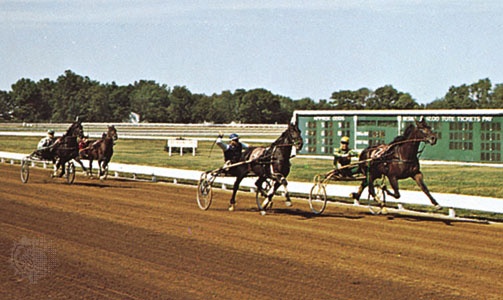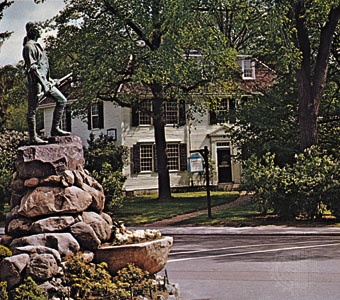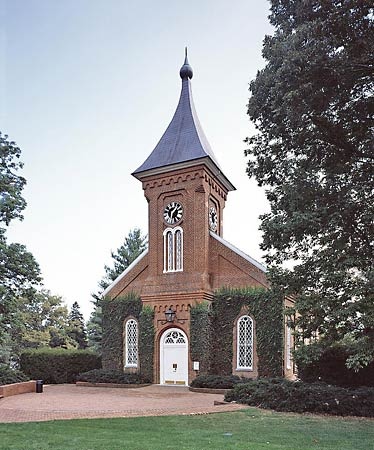Lexington
Kentucky, United States
 city, coextensive with Fayette county, north-central Kentucky, U.S., the focus of the Bluegrass region and a major centre for horse breeding. Named in 1775 for the Battle of Lexington (Lexington and Concord, Battles of), Massachusetts, it was chartered by the Virginia legislature in 1782 and was the meeting place (1792) for the first session of the Kentucky legislature following statehood. Lexington in the early 1880s called itself the Athens of the West, boasting Transylvania College (1780; now Transylvania University), street lights, a public subscription library, a theatre, and a musical society. In 1817 it had presented the first Beethoven symphony heard in the United States.
city, coextensive with Fayette county, north-central Kentucky, U.S., the focus of the Bluegrass region and a major centre for horse breeding. Named in 1775 for the Battle of Lexington (Lexington and Concord, Battles of), Massachusetts, it was chartered by the Virginia legislature in 1782 and was the meeting place (1792) for the first session of the Kentucky legislature following statehood. Lexington in the early 1880s called itself the Athens of the West, boasting Transylvania College (1780; now Transylvania University), street lights, a public subscription library, a theatre, and a musical society. In 1817 it had presented the first Beethoven symphony heard in the United States. horse racing on the town common was prohibited in 1788, and the racecourse was rebuilt in another part of town. Devotion to fine racing horses remains a local passion, with flat racing at Keeneland and trotting at the “Red Mile.” The American Thoroughbred Breeders Association has its headquarters in Lexington. Surrounded by rich farmlands, the city is an important market for beef cattle, sheep, spring lambs, bluegrass seed, and loose-leaf tobacco. Its manufactures include bourbon whiskey, printed products, construction and mining equipment, computer software, and telecommunications and electronic equipment. The University of Kentucky (Kentucky, University of) and Lexington Theological Seminary were founded there in 1865; there are also two business colleges, and Lexington is headquarters for the Kentucky Community and Technical College System, established in 1997.
John C. Breckinridge (Breckinridge, John C), vice president of the United States in 1857–61, as well as the Confederate general John Hunt Morgan (Morgan, John Hunt), members of the Todd family, and U.S. Senator Henry Clay (Clay, Henry), are buried in Lexington Cemetery. The homes of Clay, Morgan, and Mary Todd Lincoln are public shrines. The Headley-Whitney Museum on the Old Frankfurt Pike displays bibelots executed in precious jewels. Lexington was incorporated as a city in 1831; in 1974 Lexington city and Fayette county merged, thus creating an urban county government. Pop. (1990) city, 225,366; Lexington MSA, 405,936; (2000) city, 260,512; Lexington MSA, 479,198.
Massachusetts, United States
 town (township), Middlesex county, eastern Massachusetts, U.S., 11 miles (18 km) northwest of Boston. Settled in 1640 and later organized as the parish of Cambridge Farms, it became an independent township in 1713 and was named for Lexington (now Laxton), England.
town (township), Middlesex county, eastern Massachusetts, U.S., 11 miles (18 km) northwest of Boston. Settled in 1640 and later organized as the parish of Cambridge Farms, it became an independent township in 1713 and was named for Lexington (now Laxton), England.The town is traditionally regarded as the site of the first military engagement (April 19, 1775) of the American Revolution (see Lexington and Concord, Battles of) (Lexington and Concord, Battles of). The event is reenacted each April at Lexington Green (called Battle Green Park); the battleground is marked by the Minuteman Statue (1900) and by a boulder and plaque inscribed with Captain John Parker's words to his men: “Stand your ground; don't fire unless fired upon, but if they mean to have war, let it begin here.” The town is a feature of Minute Man National Historic Park (1959). The Hancock-Clarke House (1698), Munroe Tavern (1695), and Buckman Tavern (1710) are among colonial buildings that have been preserved. In 1839 the first public normal (teachers' training) school in the United States (later moved to Framingham) was established in Lexington.
In addition to its standing as a tourist centre, Lexington has a strong manufacturing sector (infrared systems, avionics, scientific instruments, camera systems, vacuum pumps, and gauges), and a still larger share of employment is provided by high-technology research and by business and financial services. The defense contractor Raytheon (Raytheon Company) is headquartered in Lexington. Many residents work in high-technology industries in the neighbouring town (township) of Bedford. Area 17 square miles (44 square km). Pop. (1990) 28,974; (2000) 30,355.
Missouri, United States
city, seat (1823) of Lafayette county, west-central Missouri, U.S., on the Missouri River (there bridged to Henrietta), 35 miles (56 km) east of Kansas City. The site, around William Jack's Ferry, was settled after 1819. The town was laid out in 1822 and named for Lexington, Ky. One of the worst steamboat disasters in history occurred there in 1852 when the Saluda exploded, killing 250. At the beginning of the American Civil War, Lexington was the most important river town between St. Louis and St. Joseph and commanded the river approach to Fort Leavenworth, Kansas. The Battle of Lexington (also known as the Battle of the Hemp Bales) (Sept. 18–20, 1861) resulted in a bloody victory for Confederate troops under Major General Sterling Price over the Union forces of Colonel James A. Mulligan. The battlefield, overlooked by Anderson House (1853; restored), which was used as a field hospital by both sides, is a state historic site. The Lafayette County Courthouse (1847) retains battle scars, and the city has a number of notable antebellum mansions. The nation's first Masonic college functioned in Lexington from 1846 to 1859, and Wentworth Military Academy was founded there in 1880. The city's economy now depends on agriculture (corn 【maize】, apples), tourism, and light manufactures (wood products, apparel). Inc. 1845. Pop. (2000) 4,453; (2005 est.) 4,632.
Virginia, United States
 city, seat (1777) of Rockbridge county (though administratively independent of it), west-central Virginia, U.S. It lies in the Shenandoah Valley, on the Maury River, 30 miles (48 km) northwest of Lynchburg. The area was inhabited by the Cherokee and Monacan peoples before the 1730s, when European settlement began. Lexington was established by the Virginia Assembly in 1777 as the county seat and named for the Battles of Lexington and Concord (Lexington and Concord, Battles of) (April 19, 1775) that marked the beginning of the American Revolution. The town was almost completely destroyed by fire in 1796. During the American Civil War, it was bombarded (June 10, 1864) by the Union troops of General David Hunter (Hunter, David).
city, seat (1777) of Rockbridge county (though administratively independent of it), west-central Virginia, U.S. It lies in the Shenandoah Valley, on the Maury River, 30 miles (48 km) northwest of Lynchburg. The area was inhabited by the Cherokee and Monacan peoples before the 1730s, when European settlement began. Lexington was established by the Virginia Assembly in 1777 as the county seat and named for the Battles of Lexington and Concord (Lexington and Concord, Battles of) (April 19, 1775) that marked the beginning of the American Revolution. The town was almost completely destroyed by fire in 1796. During the American Civil War, it was bombarded (June 10, 1864) by the Union troops of General David Hunter (Hunter, David).Lexington is the seat of Washington and Lee University (founded as Augusta Academy in 1749) and the Virginia Military Institute (VMI; founded 1839). The former was named for George Washington (Washington, George), its greatest benefactor, and for the Confederate general Robert E. Lee (Lee, Robert E.), who served as its president from 1865 to 1870. The Stonewall Jackson Cemetery holds the graves of Thomas “Stonewall” Jackson (Jackson, Thomas Jonathan), Robert E. Lee, and many other Confederate soldiers. Nearby are Natural Bridge, House Mountain, and Goshen Pass. Lexington was the birthplace of Sam Houston (Houston, Sam), the Texas military hero, and Cyrus McCormick (McCormick, Cyrus Hall), inventor of the mechanical reaper.
Aside from its status as a “shrine of the South,” it is also the shopping centre for an agricultural area (beef cattle, sheep, and dairying). Its economic mainstays are education-based services and tourism. Inc. town, 1841; city, 1966. Pop. (1990) 6,959; (2000) 6,867.
county, South Carolina, United States
county, central South Carolina, U.S. It lies between the North Fork Edisto River to the southwest and the city of Columbia and the Congaree River to the east. The county is also drained by the Saluda River, which is impounded by the Saluda Dam to form Lake Murray. Lexington county's southernmost portion lies in gently rolling Coastal Plain terrain, the central portions lie in fall line hills, and the northern sections, with pine and hardwood forests, fall in the Piedmont.
The region was once the home of Saluda Indians. During the colonial era it included many German settlers in Saxe-Gotha township, one of the South Carolina colony's original townships. Fort Granby was the site of two battles during the U.S. War of Independence (American Revolution); a trading post in nearby Cayce was alternately held several times by British and American forces. The county was formed in 1804 and named for the Battle of Lexington (Lexington and Concord, Battles of). After 1950 this suburban region's population growth was among the most rapid in the state.
The county is prosperous; its per capita income is among the highest in South Carolina, and the unemployment rate among the lowest. Lumbering is important to the economy, as are agriculture (chickens and peaches), health care, and manufacturing (computers, electronic equipment, textiles, steel, and copper). The town of Lexington is the county seat, and the Columbia suburbs of Cayce and West Columbia are the largest cities. Area 701 square miles (1,815 square km). Pop. (2000) 216,014; (2007 est.) 243,270.
- Superior
- Superior Bay
- Superior, Lake
- Superior Upland
- Superman
- superman
- Super Mario Bros
- supermarket
- supernaturalism
- supernova
- Supernova 1987A
- Super Outbreak of 1974
- superposed order
- supersonic flight
- superstition
- supersymmetry
- supertanker
- Supervielle, Jules
- Suphan Buri
- Supilo, Frano
- Suppiluliumas I
- supplejack
- supplicatio
- supply and demand
- supply curve